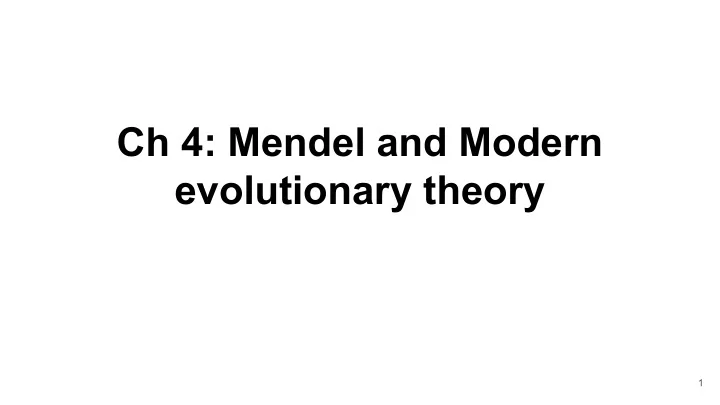

Ch 4: Mendel and Modern evolutionary theory 1
Mendelian principles of inheritance Mendel's principles explain how traits are inherited from one parent to offspring. Background: Eight years breeding pea plant hybrids . 2
Mendel's experiments -Crossed purebred pea plants Parent generation: - Tall pea plants x short pea plants F1 generation: F2 generation: 3
First principle of inheritance Alleles: Variations of a gene. Ex: Pea plant height is controlled by an allele pair . Principle of segregation: Traits are controlled by allele pairs and each parent contributes one allele to each pair. 4
Dominance and recessiveness Dominant alleles mask the expression of recessive alleles Homozygous: two allele copies Heterozygous: different alleles 5
Mendel's principles of inheritance Genotype: Organism's actual genetic makeup Phenotype: Observed expression of genotype/genes. 6
Punnett square problems Identify the different phenotypic and genotypic ratios in F2 generations for a cross of two heterozygous tall plants (tall = dominant trait). 7
Second principle of inheritance Principle of independent assortment: Traits are inherited separately. -Inheritance of one trait is independent from inheritance of other traits 8
Mendelian genetics recap Alleles: variations of a gene Allele pairs determines trait Genotype determines phenotype Tt determines tall pea plants 9
Mendelian genetics recap Dominant alleles mask the expression of recessive alleles. Homozygous: allele pairs (TT or tt) Heterozygous: alleles pairs (Tt) 10
Mendelian genetics recap Principle of segregation: traits are controlled by discrete units which come in pairs and separate into sex cells. Principle of independent assortment: traits are inherited separately. 11
Punnett square problems Hypothetically, B is the allele that causes brachydactyly. If a man with two normal alleles (bb) has average length fingers/toes has kids with a woman with brachydactyly (Bb). What proportion of their kids will have average length fingers/toes? 12
Genetics Mendelian traits -Discrete traits -One gene determines one trait -Rarely influenced by environment Polygenic traits -Continuous -Multiple genes determine one trait -Heavily influenced by environment 13
Genetics Mendelian traits -Discrete traits -One gene determines one trait -Rarely influenced by environment Polygenic traits -Continuous -Multiple genes determine one trait -Heavily influenced by environment 14
Punnett square problems Hypothetically, B is the allele that causes brachydactyly. If a man with two normal alleles (bb) has average length fingers/toes has kids with a woman with brachydactyly (Bb). What proportion of their kids will have average length fingers/toes? 15
Ch 4: Modern Synthetic Theory of Evolution 16
Modern Synthesis Evolution: change in allele frequencies of a population from generation to generation. Gene pool: "All of the genes shared by the reproducing members of a population (Jurmain et al. 2016: 85)." 17
Synthetic theory of evolution Two-stages of evolution Stage 1: (microevolution) Factors produce and redistribute variation. Stage 2: (macroevolution) Natural selection acts on variation. Microevolution: changes from generation to generation. Macroevolution: (speciation) changes over geologic time. 18
Mutations Mutations: any change in alleles -Produces new alleles (only source of new genetic material) -Only inherited if occurs in gametes Ex: Sickle-cell anemia = point mutation (changes in a single base). 19
Recombination -Chromosome pairs exchange DNA during meiosis. -Greater genetic diversity for natural selection to act on. 20
Genetic drift (two types) Genetic drift: changes in allele frequencies due to chance. Founder effect Ex: Polydactyly in Amish communities -Founders = carriers -Homozygous recessive individuals arose in gene pool. 21
Genetic drift (two types) Genetic drift: changes in allele frequencies due to chance. Founder effect: small subpopulation starts new popn. Bottleneck: population shrinks and recovers Ex: Pingelap islanders are mostly colorblind. 22
Gene flow (migration) Gene flow: (migration) exchange of genes between populations. Ex: Low occurrence of hominin speciation in the past million years explained by migration. 23
Variation and natural selection Natural selection -Directional change relative to environment -Acts on variation produced and redistributed by mutations, recombination, genetic drift, and gene flow 24
Natural selection Natural selection: -Directional change relative to environmental context. -Acts on variation produced and redistributed by mutations, recombination, genetic drift, and gene flow. 25
Anthropology example Sickle-cell anemia: genetically inherited blood disease -Mutated hemoglobin allele -Collapses red blood cells into sickles 26
Anthropology example Expect: selection against sickle-cell trait Instead: 30% some regional populations are carriers 27
Anthropology example Correlation between geographic locations with a malarial pressure and high frequencies of SCT 28
Anthropology example Geographic distribution: Mediterranean, Arabian peninsula, Southeast Asia, West Africa. 29
Sickle-cell trait: Natural selection in humans 30
Recommend
More recommend